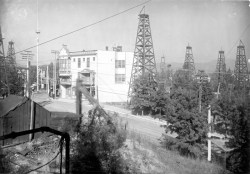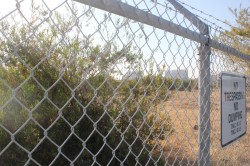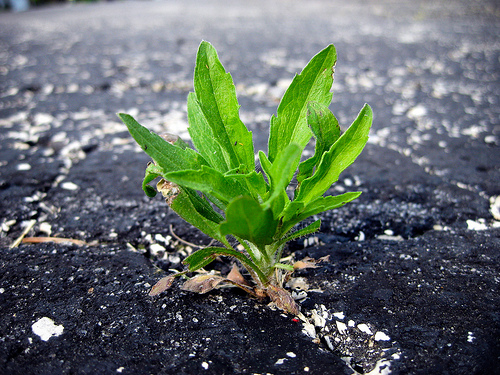This is the last in a four-part series about the Los Angeles River. Read the other parts here, here, and here.

Photo by ryanoshea.
One of the strangest things about the Los Angeles River might be how, after a century of neglect and outright abuse, it somehow still offers scraps of wildness amidst a sprawling metropolitan region of 13 million people.
Now that more and more people are interested in saving the river, these survivor wildernesses are no longer the sad remnants of what’s been lost; they’re pioneering examples of what might be possible in a wilder, more sustainable city.
This shift in perspective is most evident in the industrial landscapes of the vast Los Angeles Basin, through which the Los Angeles River flows in its final stretch from downtown to the massive Port of Long Beach. Here, amid a landscape of brownfields and oil infrastructure, scraps of the river’s wetlands and sloughs offer glimpses of what is possible.
The Los Angeles Basin was once a shallow sea, where carbon-rich corpses from teeming, ancient reefs were buried for millions of years, then became the lucky destiny of Jazz Age oil barons. We don’t often think of L.A. as an oil town anymore, but refineries, tank farms, pipelines, and chemical plants still loom large in the basin’s landscape. Pumpjacks bob away in incongruous places such as the sideyard of an apartment building, or next to the running track at Beverly Hills High School.

Los Angeles’ forgotten oil boom. (Photo courtesy of Wikimedia Commons.)
Other industries followed oil, from aerospace to plastics. Today, though, partly due to the easy global trade on hand at the nearby Port of Long Beach, large expanses of the basin’s landscape are abandoned, and in the absence of any economic use, old wetlands are making a surprising comeback.
Few weeks ago, Jessica Hall, a Los Angeles landscape architect who also co-authors the excellent L.A. Creek Freak blog, showed me around some of the little-known wetlands of the old Dominguez Slough, hidden in the South Bay cities of Torrance, Gardena, and Carson.
We visited sites like the Gardena Willows Wetland Preserve, a nine-acre wedge of thickly grown greenery sandwiched between a shopping center parking lot and a tract home development. From there, Hall showed me a couple other pieces of the old Slough — one that ran through the middle of a trailer park, and another that flowed in a marshy ditch between a golf course and an airfield for the Goodyear Blimp.
These patches of untended wildness were scraps of real estate left over from larger developments, but they still provide places where marsh plants like tule grass and willow trees can unobtrusively filter polluted water and provide wildlife habitat.
Hall contrasts these neglected wetland pockets to a newly opened wetland park located nearby, in south Los Angeles. The park has been heralded as an example of the city’s new approach to “green infrastructure,” and Hall acknowledges that it does a lot of great things: It replaced a little-used parking lot with greenery in a neighborhood that lacks access to open space, and its wetlands are designed to filter polluted stormwater.

The new South Los Angeles Wetlands Park. (Photo courtesy of The City Project.)
But she also points out that the new park harbors a big contradiction: To supplement its ponds and establish its plantings, it has been using city tap water, imported from hundreds of miles away, from more vulnerable wetlands in dryer parts of the inland desert.
To underscore the irony, Hall took me to another wetland, located on an abandoned and cleared industrial site in the city of Torrance, not far from the ExxonMobil refinery that produces much of the Golden State’s gasoline.
There, behind a serious chain link fence, I saw a large dusty meadow with a cluster of shrubs and a few small trees. It didn’t look like much, but others (including Google Earth) had seen this meadow flood with water in the wetter months. The shrubs, Hall told me, were mule fat — a species that indicates the presence of seasonal wetlands or ephemeral streams (and, as the name might imply, a good source of food for birds and grazing mammals).
This abandoned lot had become, without anyone’s help, one of the seasonal wetlands that once existed throughout the southern Los Angeles Basin.
Comparing this site with the city’s expensive new wetlands park, Hall throws up her hands. “It’s such an L.A. way of doing things — it’s just superficial,” she says of the wetlands park. “We don’t need to handhold people and give them fake nature! Just take the fences down, daylight the creeks, and let people experience these places on their own!”

A wetland appears on the site of a former paint factory. (Photo by Christian MilNiel.)
Decision makers are still a long way from embracing ideas like these, or even really understanding them, as a cohesive means to an end — even if they’re on board with the overall vision of a more sustainable watershed.
But even though volunteer wetlands like the one in Torrance are being left out of restoration efforts for the time being, the region is still making slow but meaningful progress overall. For instance, this stronghold of car culture is in the midst of one of the nation’s most ambitious transit expansions. The toxic ruins of chemical factories are being cleaned up and rededicated as riverfront parks. The city council even voted recently to ban plastic bags at grocery stores, in part because they were clogging local waterways after rainstorms (council member Ed Reyes called plastic bags “the graffiti of the Los Angeles River”).
Each of these small victories recruits more people to believe in the possibility of a healthier, wilder river, and a more sustainable city.
Lots of environmentalists like to dismiss Los Angeles as a lost cause. But any environmentalist who persists in that point of view is missing out on what could well be one of the most amazing conservation success stories of our generation: the transformation of a smog-ridden, sprawling metropolis into a role model for rising above the mistakes of the 20th century.
The progress in making that transformation can feel frustratingly slow and fraught with mistakes. But the radical vision of a clean, verdant Los Angeles River — the centerpiece of a watershed where families can walk to their neighborhood creek to cool off, and where herons and fish thrive where oil tanks and parking lots used to be — is building its own momentum, and carrying the city forward.



